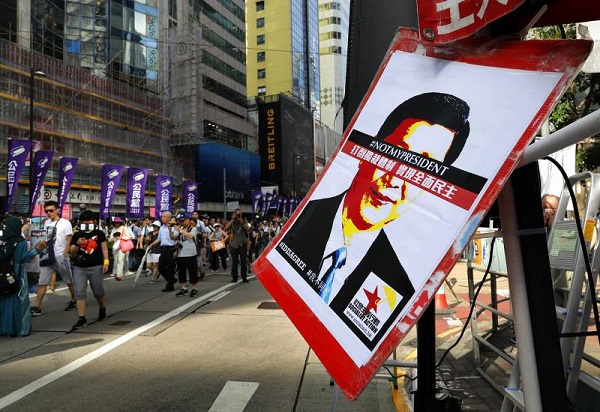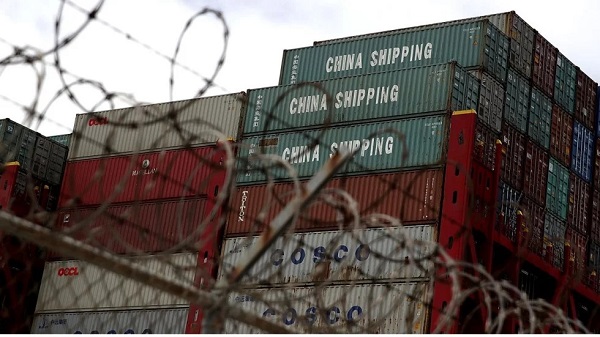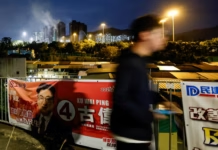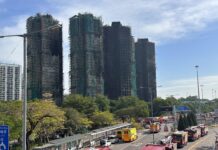Introduction to the Commission on China at the CWI School 2018 by Pasha of Socialist Action (CWI in Hong Kong)
The past one year can be described as a year of big changes in China – showing a deepening crisis of the one-party dictatorship and China’s special form of state capitalism. There has been a historic change in the ‘Communist Party’ (CCP) regime’s structure with the coronation of Xi Jinping as ‘ruler for life’ in March.
In the class struggle, since April, we have seen a series of daring strikes that have spread across many provinces. And in world relations the US-China conflict has sharpened dramatically. This is the most important global power conflict between the two biggest economic powers.
China’s trade ministry described President Trump’s tariffs imposed on July 6 as “the largest trade war in economic history”. It is not yet the “biggest ever” but further escalation is possible. The US-China conflict is not a passing phenomenon; it is now a permanent reality, with ups and downs, that forms a crucial part of the CWI’s perspectives for world capitalism.
And we also have a new phase of China’s economic malaise. The regime’s crackdown on debt and shadow banking has led to a new economic slowdown and once again at least a partial shift back to stimulus policies i.e. more debt. This shift can become bigger in the months ahead. China’s debt problem is a problem for the entire global capitalist system. No country in history has built up so much debt.

Reversal of Deng
The March meeting of the National People’s Congress – China’s pseudo parliament – was dubbed the coronation of Xi Jinping. It removed the term limits on the presidency so Xi can rule for life.
Since the late 1970s, China has been ruled by a form of ‘collective leadership’, a system set up by Deng Xiaoping, the architect of China’s return to capitalism. Deng’s power sharing model, and other political rules, were designed to safeguard ‘stability’ and prevent power struggles within the state from going too far and threatening the existence of the dictatorship.
Since the 2007-08 global crisis of capitalism the CCP ruling elite need a “strongman”, with unprecedented centralised power, to rescue it from its own crises – mounting debt and growing mass unrest.
In six years since he came to power, Xi has waged an extensive anti-corruption drive, which is partly about corruption and gaining public support, but mainly has been used to consolidate Xi’s position and defeat any opposition. But rather than overcoming the tensions within the Chinese state and ruling elite, Xi’s consolidation of power has raised tensions to a potentially higher level.
Despite massive censorship of the internet, netizens in China were quick to express their cynicism and opposition online towards Xi’s coronation with satirical metaphors. The internet censors had to quickly ban a whole list of words such as “two-term limit”, “constitutional amendment”, “I disagree”, “North Korea”, and even “Winnie the Pooh”.
This exposed the true level of support for Xi among the masses. Some commentators described Xi as the strongest leader since Mao, but Mao was a Bonapartist ruler at the head of a movement that overthrew capitalism in China; the gigantic cult of personality that the regime built around Mao was only possible because of his role in the revolution.
Xi Jinping presides over a state capitalist system and his real support base among the masses is exaggerated. His power rests mainly on repression, nationalism, massive media ‘brainwashing’, and that some sections of the population still experience improvements. But this is more and more precarious. The foundations of Xi’s rule – unprecedented levels of debt, increased repression and nationalism – constitute a succession of crises waiting to happen.
Repression and backlash
Now state repression is the worst since 1989. The government budget for internal security was 193 billion USD last year – it has tripled since 2007. This is 19 percent higher than China’s military budget.
In the Muslim region of Xinjiang, which is half the size of India, China has built “the perfect police state” says the Guardian newspaper. Between 500,000 and 1 million Muslim Uighurs have been detained in military-style prison camps – up to one in ten of the population. The CCP now rules Xinjiang through an openly racist apartheid-style system with more repressive laws for Muslims.
Despite having arguably the most sophisticated repressive state machinery in the world, mass resistance and protests are growing. Since late 2017, the masses in China have boldly taken part in large-scale online protests, and multi-province workers’ strikes, representing a dramatic turn.
In April, crane drivers went on strike in at least 13 provinces demanding better pay and conditions. They then called for a nationwide strike on May Day. Given the state repression and censorship, this is a feat in itself. These struggles are organised through closed online chat groups and instant messaging apps.
Multi-province strikes
The crane drivers’ strike was historic in the sense that was the most impressive, coordinated and daring action to date. Previously almost all strikes in China were in one factory or one district. A nationwide strike is a very big change. The April struggle seemed to open the floodgates for nation-wide struggles.
In June, it was the truck drivers turn. Truck drivers struck in more than 12 provinces protested against rising fuel costs, high road tolls, police harassment and increased exploitation by an Uber-style hiring app. The truck drivers’ action was in cities from Chongqing in the West to Shanghai in the East. That is similar to the distance from Madrid to London. To do this under the world’s most powerful dictatorship is impressive.
And since April, army veterans in multiple provinces had been staging protests demanding payment of pensions and retirement benefits. Some veterans were beaten up by gangsters paid by the local CCP governments. Through links and networks in the army, tens of thousands of veterans were mobilised to protests in solidarity from across the country.
The army veterans struggle is important because for one it undermines Xi Jinping’s nationalist propaganda. There are 57 million retired soldiers in China. This issue may also impact on serving soldiers. How can the state defend the “Chinese nation” if it lets its old veterans starve and beats them up when they protest?
Earlier this year the government set up a new Ministry of Veterans Affairs because it was so worried about the veterans’ protests. But the fact that protests erupted anyway shows the limits of the state to deal with these problems.
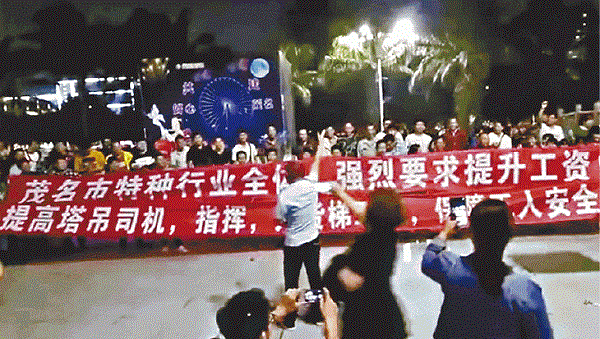
#Metoo in China
Amongst other important movements in China are the feminist and LGBT movements. The #Metoo movement that swept the world also affected China deeply. In January, a Chinese academic working in the USA revealed online that she was sexually assaulted by her professor twelve years ago. Her tweet went viral and got huge support online among women in China
This triggered a movement online especially in schools and colleges. This even forced the state to pay lip service and condemn sexual violence. At the same time, the CCP feared the movement would get out of control and so quickly banned any attempts to organise protests on the streets. A prominent feminist blog was banned.
The state censors then moved to ban LGBT topics. Weibo, the main blogging platform in China, announced it would remove “illegal content” including “homosexuality”. This triggered a massive backlash. The #IamGay campaign called for a boycott of Weibo. With over 500 million shares, it was probably the largest online movement in the world. It forced the company and the authorities to reverse the ban on homosexual content.
From the recent wave of struggles there are several features we can observe. Mass struggles in China are getting more organised despite state repression and censorship, capable of staging and coordinating struggles across the whole country. Workers are clearly learning from the past, they are realising that the problems cannot be solved locally.
Radicalisation of mass consciousness is also a feature, although it is uneven. Workers generally confine their demands to economics, and avoid challenging the CCP regime directly, partly to avoid state repression and partly due to lingering illusions in the CCP.
If the regime resorts to repression and crackdown, which is definitely the pattern under Xi Jinping, it is only a matter of time before workers draw conclusions that the dictatorship is a barrier to any real change and this will turn their struggles in a more clearly political direction.
Economic slowdown
The Chinese economy is facing crises on multiple fronts. The economy is in a slowdown after a short period of slight recovery in 2017. Since the start of 2018 the stock market has lost US$2 trillion, compared to US$5 trillion in the big stock market crash of 2015.
Economic data in the 2nd quarter is likely to be much weaker than the 1st quarter. The retail figures in May were the worst in 15 years. The investment growth rate is the weakest for 20 years. Debt as a share of GDP has risen from 141 percent in 2008 to 256 percent last year. This figure rises to 304 percent of GDP if shadow banking is included. Actually, the real level of debt is much higher. This is because most of the shadow banking debt is not recorded. Even the government doesn’t know the full picture.
The latest slowdown forces the CCP to revive the stimulus strategy again. For ten years we have seen the same zig zag in economic policy – from stimulus to credit squeeze and back to stimulus i.e. more debt. The debt problem is particularly dire at the local government level (local governments in China refers to towns, cities and also provinces, so some are bigger than most national governments in Europe or globally).
This was partly the cause of the protests of army veterans. In fact, the local governments in at least 32 cities of six provinces now finance their social security and pension expenditure with loans from banks or shadow banks. This problem will only get worse with the rapidly ageing population of China.
A city in Hunan province was unable to pay its civil servants on time in May. Such wage arrears – for civil servants – were the first in modern China’s history. We are already seeing the debt crisis turning into a social crisis, and we are going to see more in the future.
Trade war and imperialist conflict
The escalation of the US-China trade war is another blow to the already vulnerable Chinese economy. On 6 July, tariffs imposed by the Trump administration on 34 billion USD worth of imports from China represented the first shot after a long period of threats. This has since been followed with tariffs on a further 16 billion USD of imports and Trump’s threat to widen this to a further 200 billion USD of Chinese goods by September.
The Chinese regime are forced to retaliate “dollar for dollar” with their own tariffs against US goods, but actually they offered concessions to Trump and desperately wanted to avoid the trade war. Within the wider trade conflict there is a “tech war”. The main focus now of US imperialism and Trump is to stop “Made in China 2025” – the CCP’s plan to become a technological superpower.
The US government sanctions which banned the 3rd largest telecom infrastructure company ZTE from buying anything from US companies, basically forced the closure of the company for 70 days in April-May. The ZTE crisis exposed China’s dependence on the West for technology. ZTE gets 90 percent of its semi-conductors from US companies.
Trump agreed to remove the ban on ZTE, but the subsequent deal is still humiliating for the company and the Chinese state. They have to pay a fine worth two years’ profits. But worse, they had to dismiss the whole board of directors and accept US “compliance officers” inside the company. This is a bit similar to what the ‘Troika’ of IMF and EU did to Greece – putting EU bureaucrats in to check the Greeks weren’t “cheating”.
The situation is complicated by the fact that even Trump has partly lost control over the trade war – the US Congress, Republicans and Democrats, now demands even tougher measures against China.
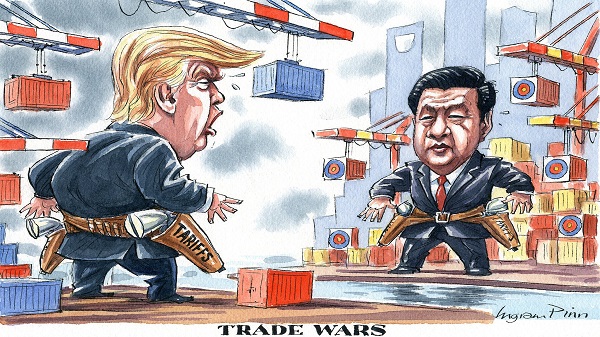
Devaluation?
As part of its retaliation, China has allowed its currency, the yuan, to fall against the dollar. However, this is a dangerous move as it could trigger mass capital flight from China, like what happened in 2015. The regime would then have to impose more capital controls.
But with more capital controls it can say goodbye to the dream of “internationalising the yuan”, to make it a global reserve currency. In fact, the yuan’s internationalisation has gone backwards in the past three years. Fewer countries want to use theChinese currency in international payments. The Swiss franc and Canadian dollar now have a bigger global share than the yuan. This matters because the domination of the US dollar in the global capitalist economy restricts the policies the Chinese regime can follow.
The US and China, the two largest imperialist powers, are contending for economic and geopolitical dominance. The confrontation between them has been sharpened by the global crisis since 2008.
While a “hot war” or direct military clash is not an immediate perspective, trade wars and other economic conflicts can become a proxy for military action. Any deals they reach in the current trade war may only be short lived and precarious. Their conflicts can further hit the world economy, which has not recovered from the severe crisis of ten years ago.
The Taiwan conflict can be reignited as part of the sharpening US-China rivalry. This can potentially lead to war or serious military crisis in the future. The capitalist crisis has also rapidly exposed Taiwan’s “pro-independence” DPP government, elected in 2016, as a neo-liberal capitalist party that also stands for increased arms spending and more deals with US imperialism, while imposing austerity on workers. None of the ruling elites, the US, China or Taiwan, have a solution and only make the situation potentially more dangerous.
The Belt and Road
Xi Jinping launched the Belt and Road Initiative (BRI) in 2013 to gain new overseas markets for Chinese capitalism’s excess capacity. Also this was to prepare for future trade wars and increased protectionism globally. The BRI was added into the CCP’s constitution last year – the first time a foreign policy was enshrined in the constitution – to signal “no reversal” of this policy.
Now the Belt and Road Initiative contains over 70 countries. It’s ambition is to especially link the underdeveloped world into a China-led economic sphere through the construction of fuel pipelines, highways, ports, railways, electric grids.
We describe the BRI as “Imperialism with Chinese characteristics”. These characteristics are state-financed loans to build infrastructure and exporting some elements of China’s authoritarian rule. There is also a military component with some BRI projects – for ports and some railways especially – mainly driven by strategic military considerations.
China’s strategy to grab land and assets in smaller, less-developed countries is simple: it gives them loans for infrastructure projects, gets control over the projects, and when the country is unable to repay the loans, Chinese companies and the state get ownership of the project.
However, China’s imperialist aspirations are already facing setbacks. Mass protests erupted in Vietnam in June against foreign capital, mainly Chinese companies. These companies bought land from the Vietnamese government on 99-year leases, arrangements reminiscent of the old treaties of colonialism. The political tsunami of the Malaysian election in May saw the new government scrap the Chinese-led Kuala Lumpur-Singapore high speed rail project.
Worldwide investment in the Belt and Road Initiative is now slowing down. In the first five months of this year, contracts signed by Chinese companies are down six percent from a year ago. The growing number of BRI debt defaults will directly impact Chinese companies, which are heavily indebted. So, the Belt and Road Initiative, originally launched by the CCP to export excess capacity and ease debt, is now part of the problem.
Crackdown in Hong Kong
The developments in China have also had significant implications in Hong Kong where the CCP is trying to decapitate the democratic struggle. The Carrie Lam government represents a further sharp escalation of repression.
Over the past year, we have had six democratically elected opposition legislators disqualified, over 40 youth and other activists being imprisoned for participating in anti-government protests, and six candidates banned from standing in elections on the grounds of support for “independence” or “self-determination”.
New draconian laws are being introduced including the national anthem law. Anyone in Hong Kong found guilty of “disrespecting” the Chinese national anthem is liable to up to three years of imprisonment.
The main bourgeois pro-democracy parties have been in full-scale political retreat. They have failed to put forward any new strategy of struggle against the authoritarian government. These ‘pan-democrats’ have in reality been a brake on the democracy struggle for decades, with similarities to the role of social democratic leaders and bourgeois nationalist leaders in other parts of the world:
- They don’t believe in mass struggle and always try to reach a compromise with the regime, which in China’s case doesn’t have any chance.
- They fear that mass movements, once they break out, will get out of control and become radicalised.
- They defend capitalism and therefore do not want to push the struggle against the Chinese dictatorship “too far” because this would also endanger capitalism.
The CWI is alone in calling for a fighting democratic movement based on a socialist programme, with a mass workers’ party as its core. We also explain that democracy including self-determination in Hong Kong can only be won by linking up with the mass struggles in China and internationally and overthrowing the CCP dictatorship.
